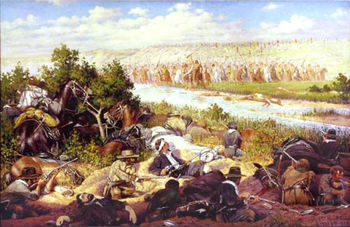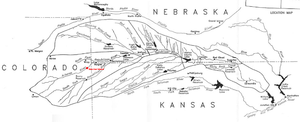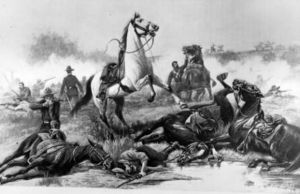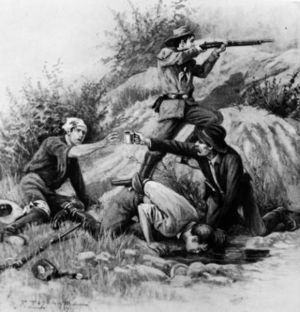Battle of Beecher Island
The Battle of Beecher Island (September 17–September 19, 1868), also known as the Battle of Arikaree Fork, was an armed conflict between elements of the United States Army and several of the Plains Indian tribes. The engagement was a notable, if somewhat overlooked, action of the Great Plains "Indian Wars" which began during the 1850's and continued on up through 1890. Beecher Island on the Arikaree River, near present-day Wray, Colorado, was named afterwards for Lieutenant Fredrick H. Beecher (nephew of Henry Ward Beecher), one of the key leaders of the Army elements who was killed during the battle. A total of six Army Scouts were killed and fifteen others wounded during the engagement, with the native forces suffering around seventy-five deaths and an unknown number of other casualties. Though the battle has been documented at considerable length, its exact location has become something of a minor controversy among military historians.
Background
In the summer and fall of 1868, continuing their annual seasonal raiding activities between the Arkansas and Platte Rivers in what was also the region of their best buffalo hunting, bands of Cheyenne and Arapaho Indians conducted raids against whites throughout the western Great Plains in Kansas. In addition they found incentive in the warfare that had been waged specifically against their clans by the military in 1867, and by memories of such atrocities as the Sand Creek massacre. Finally, the westward movement of the transcontinental railroad had stretched all the way across Kansas, bringing with it with many permanent white settlements. During the 1867-1868, the Cheyenne were in schism, with those advocating peace (possibly a majority) retreating south out of Kansas and the younger, intractable warrior societies continuing to raid. The latter during the summer of 1867 had successfully avoided a large expedition commanded by Major General Winfield S. Hancock, and in the process had garnered sympathy from settlers in the East who supported peaceful negotiations after Hancock attempted to bully the Cheyenne to submit and burned their abandoned villages when they failed to capitulate.
In August of 1868, General Philip Sheridan, having replaced Hancock in command of the Department of the Missouri, was asked by acting Governor Frank Hall of Colorado for assistance after 79 settlers were killed in repeated attacks on farms, ranches, way stations, and travelers. Sheridan's main effort was to be made south of the Arkansas, a winter campaign in the Indian Territory, but he remained active in Kansas during the warmer weather, patrolling the Arkansas with the 7th Cavalry Regiment and the area between the Republican and Smoky Hill Rivers using the 10th Cavalry. To protect the railroad, Sheridan ordered his aide, Major George Alexander Forsyth of the 9th Cavalry Regiment, a Civil War veteran, to raise a company of civilian scouts to seek out and engage the marauders using their tactics, rather than those of the Army. Forsyth hand-picked 48 men at Fort Hays, all armed with Spencer repeating rifles. Forsyth's executive officer was Lieutenant Fredrick H. Beecher of the 3rd Infantry, a decorated veteran of the Battle of Gettysburg. His company marched west and reached Fort Wallace the night of September 5 without finding any trace of Indians.
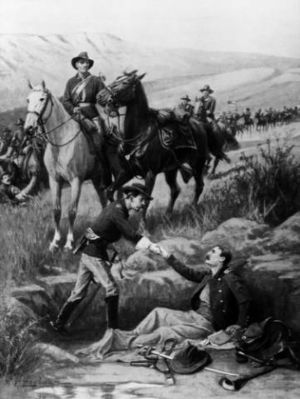
"The Rescue." A soldier offers aid to his wounded comrade after the Battle of Beecher Island.[1]
The engagement
September 10
Forsyth (in the rank of Brevet Colonel) and his group departed Fort Wallace with orders to counter a raid on the Kansas Pacific rail head near Sheridan, Kansas about 13 miles (21 kilometers) to the east.[2]
September 11–16
The Scouts trailed the Indian raiding party from Sheridan into Colorado; signs indicated that the opposing force considerably outnumbered the Scouts (the raiding party consisting of some 25 Indian braves), but the unit nonetheless pressed on. Around dusk on the 16th Forsyth and his men arrived in the vicinity of the "Dry Fork of the Republican River" (reported at the time as "Delaware Creek"—now the Arikaree River) and made camp on the south bank 12 miles (19 kilometers) from two Lakota villages.[3][4]
September 17–19
Come dawn on the 17th, Forsyth (sensing trouble) spotted the silhouette of a feathered head against the skyline. He fired his weapon, instantly killing the Indian warrior. Simultaneously, other Indians that had moved nearer to where the Scouts' horses were tied up attempted to stampede them, but the soldiers immediately responded to the sound of Forsyth's gunshot and only the pack mules were lost. Roman Nose, war leader of the Cheyenne, had planned a dawn raid to overrun the camp of 50 U.S. Scouts, but the element of surprise was lost when a few eager warriors rushed the camp before the order to attack was given. Forsyth gave orders to saddle the horses. Surmising that no escape route was open, he directed his men to take cover on a sand bar in the middle of the Arikaree. Estimates as to the size of the attacking Indian force vary between a low of 200[5] to as many as 1,000.[6][7] Regardless of the actual number of warriors, the assualt was repelled by the Scouts' superior firepower. Following the initial exchange, small parties of Indians intermittently dashed up to the sand bar on horseback, inflicting little damage on the Scouts, who had and dug "gun pits" into the soft sand and killed their horses in order to use their carcasses as temporary fortifications.[8] The natives surrounded the island and repeatedly attacked the Scouts, several of whom were killed or wounded by Indian snipers hidden in the tall grass.[7]
Many native warriors fell, including Roman Nose who was shot on the riverbank at the west end of the sand bar and died around 10 o'clock that evening.[7] Four of the Scouts (Beecher, Acting Surgeon J.H. Mooers, George W. Culver, and William Wilson) also died of their wounds and were subsequently buried on the Island. 15 scouts were wounded, among them Colonel Forsyth who received a minor head wound and fractured leg resulting from a gunshot wound.[5] During the first night Colonel Forsyth sent a few scouts to summon assistance from Fort Wallace, more than 60 miles (94 kilometers) away.[9][10] Lieutenant Simpson "Jack" Stilwell and Scout Pierre Trudeau made good their departure after nightfall evading Indian forces for four days as they made their way inexorably toward reinforcements.[11]
September 20–24
Two nights after Stilwell's and Trudeau's departure, Scouts John J. Donovan and Allison J. Pliley left the Island to seek relief as it was not known whether-or-not Stilwell and Trudeau had made it through the Indian lines. During this time Forsyth and his men (who had exhausted their rations) sustained themselves on muddy river water and rotting horse meat.[7]
September 25–27
On September 25 elements of the 10th Cavalry Regiment ("Buffalo Soldiers") under Lieutenant Colonel Louis H. Carpenter (one of three resue parties sent out from Fort Wallace) arrived to relieve Forsyth's unit. Forces of the 2nd Stryker Cavalry Regiment and about 100 men of the 5th Infantry Regiment came upon the scene a short time after.[12] The following day, Scout Lewis Farley died of his wounds and was buried on the battlefield with the other four scouts. Scout Thomas O'Donnell died of his wounds on November 18 at the Fort Wallace Hospital and was laid to rest in in the Fort Wallace Cemetery.[12] As On September 27 the "Forsyth Scouts" departed for Fort Wallace escorted by the 10th Cavalry. Accounts by Army personnel indicated that seventy-five Indians were killed, with no estimates placed on the number of natives who sustained non-life threatening injuries.
Aftermath
The "Forsyth Scouts" arrived back at Fort Wallace on September 30. Brevet General George Armstrong Custer later proclaimed that the Arickaree fight was "…the greatest battle on the Plains." To the Cheyenne, the engagement would be remembered as "The Fight when Roman Nose was Killed." In actuality, the fight was a minor engagement of no lasting import whose greater significance, as a model for tactics in successfully combating the Indians, was largely ignored. On or about December 31, 1868, the Forsyth Scouts were disbanded. The following spring an Army detachment returned to recover the Scouts' bodies. While the remains of Culver and Farley were located, the graves of Beecher, Mooers, and Wilson were empty, the remains having apparently been removed by Indians. The bodies of Culver and Farley were exhumed and reinterred at Fort Wallace.[7]
A monument was established by J.J. Peate (a member of one of the rescue parties) in 1905. The marker was washed away in the Arickaree River Flood of 1935, and a new one erected about 200 yards south of the original spot. The location of the Battle, now a subject of controversy, was nonetheless designated as a National Historic Site in 1976.
Historic designations
- National Register of Historic Places #NPS–76000569 — "Beecher Island Battleground Memorial" site
- Colorado State Register Property
Notes and references
- ↑ The Harper's article states that this is Brevet Colonel Louis H. Carpenter greeting Lieutenant Colonel Forsyth, who was twice wounded.
- ↑ Kansas Pacific Railway (1870). Hand Book for the Kansas Pacific Railway. Retrieved on 24 July 2013.
- ↑ Zion, Lee C. Forsyth Scouts, Beecher Island 17–25 September 1868. History of the Regiment. Retrieved on 24 July 2013.
- ↑ Smallbone, Chris (March 2006). 1865-9 Clearing the Central Plains for the Railroad. Retrieved on 24 July 2013.
- ↑ 5.0 5.1 Sheldon, Addison Erwin (1913). The Battle of Beecher Island. Retrieved on 24 July 2013.
- ↑ (2005) “Winning the West: The Army in the Indian Wars 1865–1890”, Stewart, Richard W., ed.: American Military History Volume 1. United States Army Center of Military History. CMH Pub 30-21.
- ↑ 7.0 7.1 7.2 7.3 7.4 Lockard, F. M. (September, 1927). "A Version Of A Famous Battle" 5 (3). Retrieved on 24 July 2013.
- ↑ The Old Trail Town Cemetery. Ultimate Wyoming Historical Site.
- ↑ Ahlquist, Diron Lacina (2003). Simpson Everett "Jack" Stilwell. Lawmen & Outlaws. Retrieved on 24 July 2013.
- ↑ Forsyth tore off the fly leaf out of his daybook, wrote a note to Colonel Bankhead at Fort Wallace, and gave it to Lieutenant Stilwell.
- ↑ Thrapp, Dan L. (1991). Encyclopedia of Frontier Biography, Volume 3: P-Z, Bison Book print. Lincoln, Nebraska: University of Nebraska Press. ISBN 978-0-8032-9420-2.
- ↑ 12.0 12.1 Carpenter, Louis Henry, Brigadier General, retired (1912). Carpenter's Recollections: The Battle of Beecher Island. Kansas State Historical Society. Retrieved on 24 July 2013. Excerpted from a letter written in 1912 from Carpenter to Mr. George Martin of the Kansas State Historical Society.
